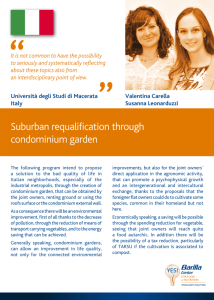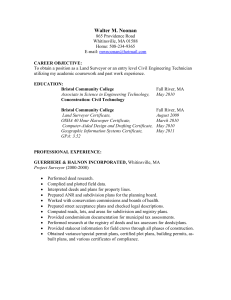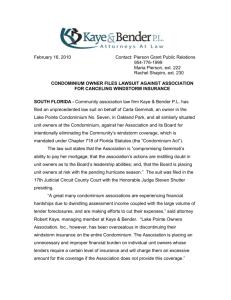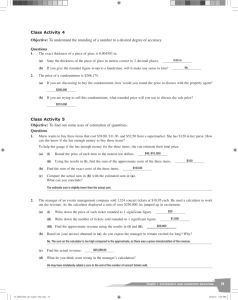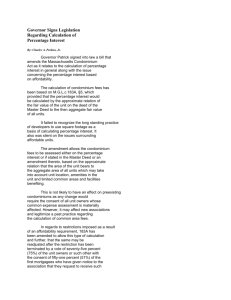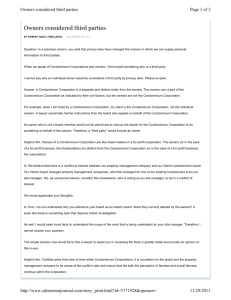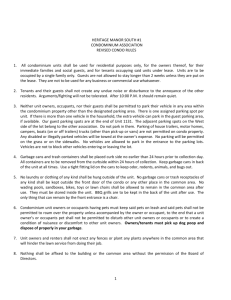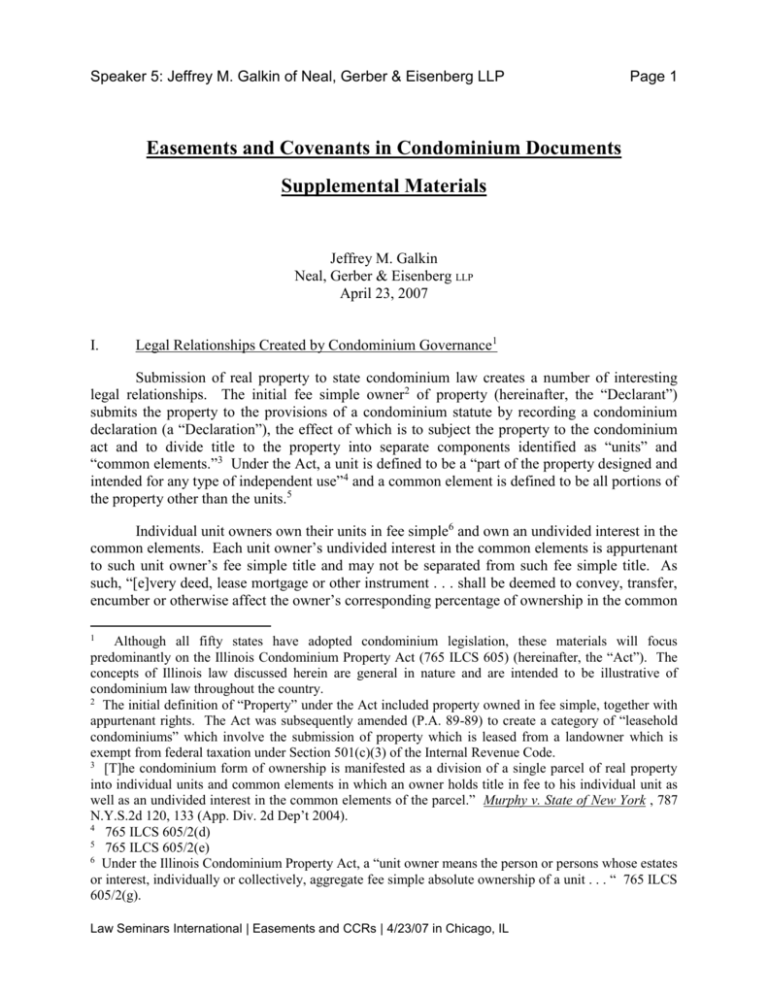
Speaker 5: Jeffrey M. Galkin of Neal, Gerber & Eisenberg LLP
Page 1
Easements and Covenants in Condominium Documents
Supplemental Materials
Jeffrey M. Galkin
Neal, Gerber & Eisenberg LLP
April 23, 2007
I.
Legal Relationships Created by Condominium Governance1
Submission of real property to state condominium law creates a number of interesting
legal relationships. The initial fee simple owner2 of property (hereinafter, the “Declarant”)
submits the property to the provisions of a condominium statute by recording a condominium
declaration (a “Declaration”), the effect of which is to subject the property to the condominium
act and to divide title to the property into separate components identified as “units” and
“common elements.”3 Under the Act, a unit is defined to be a “part of the property designed and
intended for any type of independent use”4 and a common element is defined to be all portions of
the property other than the units.5
Individual unit owners own their units in fee simple6 and own an undivided interest in the
common elements. Each unit owner’s undivided interest in the common elements is appurtenant
to such unit owner’s fee simple title and may not be separated from such fee simple title. As
such, “[e]very deed, lease mortgage or other instrument . . . shall be deemed to convey, transfer,
encumber or otherwise affect the owner’s corresponding percentage of ownership in the common
1
Although all fifty states have adopted condominium legislation, these materials will focus
predominantly on the Illinois Condominium Property Act (765 ILCS 605) (hereinafter, the “Act”). The
concepts of Illinois law discussed herein are general in nature and are intended to be illustrative of
condominium law throughout the country.
2
The initial definition of “Property” under the Act included property owned in fee simple, together with
appurtenant rights. The Act was subsequently amended (P.A. 89-89) to create a category of “leasehold
condominiums” which involve the submission of property which is leased from a landowner which is
exempt from federal taxation under Section 501(c)(3) of the Internal Revenue Code.
3
[T]he condominium form of ownership is manifested as a division of a single parcel of real property
into individual units and common elements in which an owner holds title in fee to his individual unit as
well as an undivided interest in the common elements of the parcel.” Murphy v. State of New York , 787
N.Y.S.2d 120, 133 (App. Div. 2d Dep’t 2004).
4
765 ILCS 605/2(d)
5
765 ILCS 605/2(e)
6
Under the Illinois Condominium Property Act, a “unit owner means the person or persons whose estates
or interest, individually or collectively, aggregate fee simple absolute ownership of a unit . . . “ 765 ILCS
605/2(g).
Law Seminars International | Easements and CCRs | 4/23/07 in Chicago, IL
Speaker 5: Jeffrey M. Galkin of Neal, Gerber & Eisenberg LLP
Page 2
elements even though the same is not expressly mentioned or described therein”. 7 The courts
have held that by virtue of their ownership of undivided interests in the common elements, the
unit owners are tenants in common.8
II.
Tenancy in Common Ownership of Common Elements
Condominium ownership and the appurtenant tenancy in common interest in common
elements is a significantly different legal relationship than that of adjacent property owners of
non-condominium property.
For example, a shared driveway serving adjoining noncondominium properties will require easement rights between the adjoining property owners. If
that same driveway is classified as a common element in the condominium context, no easement
rights would be required as all condominium unit owners have the legal right to the use and
enjoyment of that driveway as tenants in common.9
The rights of condominium owners as tenants in common to the use and enjoyment of
condominium common elements has been consistently recognized by the courts. In Stuewe v.
Lauletta, 418 N.E.2d 138 (Ill. App. Ct., 1st Dist 1981), the court rejected a developer’s attempt to
assign portions of the common elements to a single unit owner for such unit owner’s exclusive
parking use on the basis that the assignment diminished the ownership and use rights of all other
owners to that portion of the common elements.10 Similarly, in Schaumburg State Bank the court
held that condominium owners could grant non-exclusive easement rights to an adjoining
property owner over a common element driveway because such non-exclusive use by the
adjoining owner did not diminish the condominium unit owners’ rights to use the driveway or
such unit owners’ percentage interests (i.e., tenancy in common interest) in and to the common
elements.11
7
765 ILCS 605/7.
Tassan v. united Development Company, 410 N.E.2d 902, 911 (Ill. App. Ct., 1st District 1980).
9
See e.g., 334 Barry In Town Homes, Inc. v. Farago, 563 N.E.2d 856 (Ill. App. Ct., 1st Dist 1990) and
Schaumburg State Bank v. Bank of Wheaton, 555 N.E.2d 48 (Ill. App. Ct., 2nd Dist 1990).
10
Id. at 140-41. See also 334 Barry in which the court rejected a condominium unit owner’s attempt to
exclusively use a portion of a common element driveway located behind such owner’s unit on the basis
that the condominium declaration governing the property did not classify the portion in question as a
limited common element, even though the unit owner in question was the only unit owner who actually
used such portion of the driveway. 334 Barry at 859. See also Grimes v. Moreland, 322 N.E.2d 699
(Ohio Ct. of Common Pleas 1974)(erection of fences by unit owners over common areas serves to
diminish each of the unit owners’ rights with respect to the common elements).
11
Schaumburg State Bank at 52. In contrast, the court in Parrillo v. 1300 Lake Shore Drive
Condominium, 431 N.E.2d 1221 (Ill. App. Ct. 1st Dist 1981) held that a condominium unit owner could
convert a terrace common element to a bedroom because the owner had a pre-existing exclusive easement
for the use of such terrace. Id. at 1223. The court distinguished the holding in Stuewe on the basis that the
rights of all other owners were diminished in Stuewe by giving a single owner a new and exclusive right
to the use of an area. In Parrillo the court held that the pre-existing exclusive easement meant that the
other owners did not suffer a diminishment in their rights to the terrace.
8
Law Seminars International | Easements and CCRs | 4/23/07 in Chicago, IL
Speaker 5: Jeffrey M. Galkin of Neal, Gerber & Eisenberg LLP
Page 3
Since the authority to grant easements over common elements is dependent upon the
nature of the easement, the express provisions of the Declaration and the consent of
condominium unit owners, it may be somewhat difficult for a third party to determine if the
easement has been validly granted. For example, the court’s holding in Schaumburg Sate Bank
permitted less than all of the unit owners in a condominium property to grant a non-exclusive
easement to an adjacent property owner. Based on the holding in Stuewe, however, all of the
owners would have had to consent to the easement grant had the easement been exclusive12
because the easement would have diminished the unit owners’ rights to the common elements.
To address this ambiguity, the Act includes several provisions which permit condominium
owners to grant certain easement and other rights in common elements based upon reduced
percentages of consenting owners. For example, Section 14.2 of the Act13 states that unless a
greater percentage is specified in the Declaration, a two-thirds majority of unit owners can elect
to dedicate portions of the common elements to a public body for street or utility purposes.
Similarly, Section 14.414 permits a vote of more than fifty percent of the owners to permit
condominium associations to grant easements to governmental bodies for protection against
water damager or erosion. Finally, Section 14.315 also permits a similar majority to approve
easements for the laying of television cable. The court in Continental Cablevision of Cook
County, Inc., 606 N.E.2d 587(Ill. App. Ct. 1st Div. 1992) explained that the express purpose
behind Section 14.3 is to clarify the authority to grant the easement and to cure potential title
defects which occur when a condominium association grants an easement.16
Tenancy in common in the condominium setting is different in many respects than
traditional notions of tenancy in common involving non-condominium tenants in common.17
While the concept of tenancy in common derives from the common law, “condominiums are
creatures of statute”.18 Condominium statutes as well as condominium declarations drafted in
accordance with such statutes introduce legal requirements and relationships which are not
known in the common law version of tenancy in common.19 For example, the various statutory
12
See also Schaffner v. 514 West Grant Place Condominium Association, Inc., 756 N.E.2d 854, 863 (Ill.
App. Ct., 1st Dist. 2001) (grant of exclusive use of parking spaces without the approval of the required
number of owners under the condominium declaration was improper where the exclusive use diminished
the rights of other unit owners).
13
765 ILCS 605/14.2.
14
765 ILCS 605/14.4.
15
765 ILCS 605/14.3.
16
Id. at 593.
17
“It appears to us that inherent in the condominium concept is the principle that to promote the health,
happiness, and peace of mind of the majority of the unit owners since they are living in such close
proximity and using facilities in common, each unit owner must give up a certain degree of freedom of
choice which he might otherwise enjoy in separate, privately owned property. Hidden Harbour Estates,
Inc. v. Norman, 309 So.2d 180, 181-2 (Fla. Dist Ct. of App., Fourth Dist 1975).
18
Schaumburg State Bank, at 51.
19
Id.
Law Seminars International | Easements and CCRs | 4/23/07 in Chicago, IL
Speaker 5: Jeffrey M. Galkin of Neal, Gerber & Eisenberg LLP
Page 4
easement provisions described under the preceding paragraph, would require the affirmative
agreement of all of the tenants in common in a non-condominium context.20
There are several other prominent differences between condominium tenancy in common
law and the common law notion. Under condominium law, for example, the declarant has the
right to designate certain portions of the common elements as limited common elements.
Limited common elements are portions of the common elements which are reserved for the
exclusive use of certain units (i.e., parking spaces, balconies and storage units).21 While all unit
owners own an undivided interest in a balcony limited common element, for example, exclusive
use of the balcony is vested with a single unit owner. This treatment contrasts with common law
notions of tenancy in common where a tenant in common has a right to use that property by
virtue of such tenant in common’s interest in the property.
Similarly, a tenant in common has a right under the common law to bring a suit for
partition in which the court will order a physical division of the property, the end result of which
will be that each former tenant in common will be left with fee simple ownership in and to a
newly divided parcel. In contrast, the Act expressly prohibits unit owners from bringing
partition actions relating to the common element.22 This prohibition recognizes that a partition
of common elements is often impractical or impossible in a condominium setting which includes
integrated, multi-owner structures (e.g., it would be impractical to partition a hallway common
element which is located on the fifth floor of a building without an elaborate set of CC&R’s).
Additional differences can be found in the Act. For example, the Act provides that
certain majorities of unit owners can force the sale of a condominium property as a whole, i.e.,
both common elements and units.23 In a non-condominium property, a tenant in common owner
would be limited to a partition action, which would likely end up with each former tenant in
common owning a piece of the divided property.24
III.
Typical Easement Rights in Condominium Documents
Although tenancy in common ownership of the common elements reduces the need for
many easements which might otherwise be required if the property were not owned in a
condominium form, it is customary for condominium Declarations to contain certain easements:
20
See also Bachewicz v. American National Bank and Trust Company, 490 N.E.2d 680 (Ill. 1986)(A coowner of real estate generally is no bound by another owner’s agreement to convey the entire property).
21
765 ILCS 605/2(s).
22
765 ILCS 605/8.
23
765 ILCS 605/15; See also, Schaumburg State Bank at 51.
24
In the event a property cannot be divided, however, the court could compel the sale of the property and
that the sale proceeds be distributed amongst the owners. This result is similar to the sale of a
condominium property described in Section 15 of the Act in that less than all of the owners could
effectively compel the sale of the property. Section 15 sets the required percentage at 75%, however.
Law Seminars International | Easements and CCRs | 4/23/07 in Chicago, IL
Speaker 5: Jeffrey M. Galkin of Neal, Gerber & Eisenberg LLP
Page 5
1.
Easements for Encroachments – Since portions of units may
encroach into other units or the common elements, it is necessary for there to be
blanket easements allowing such encroachments to be maintained. See appendix
for sample language.
2.
Easements to Utility Providers – Although the Act provides a
method for granting easements if and when the future need for utility easements
arises, it is typical for a Declaration to include a blanket easement at the outset to
eliminate the need to obtain the consent of unit owners. See appendix for sample
language.
3.
Easements in favor of the Association – In order to permit the
Association access to units as may be required to discharge the Association’s
responsibilities with respect to the condominium property as a whole, a blanket
easement is granted to the association access. See appendix for sample language.
4.
Easements in favor of the declarant – As it is not uncommon for a
declarant developer to commence with sales of units prior to the completion of all
units in the project, it is necessary for the developer to continue to maintain the
right to enter and use portions of the condominium property for sales and
development activities. See appendix for sample language.
5.
Cross Easements During Development – As described in the
preceding paragraph, the construction and sales of units in a condominium project
may be on different schedules, i.e., units may be completed on a floor by floor
basis. Since the Act requires a Declarant to commence payment of condominium
assessments upon the conveyance of the first unit,25 it is rather common for a
declarant to submit a building to the terms of the Declaration and the Act on a
floor by floor basis.26 This affords the declarant the benefit of selling units before
the entire project is complete and to delay payment of assessments on units which
are not ready for sale. During periods of time when such an integrated structure is
partially governed by the Act and partially under development, the condominium
and non-condominium portions of the property will be structurally and
operationally interdependent. As such, the property requires cross-easements and
covenants similar to a set of CC&Rs which would govern a mixed-use project.
Such easements would govern, among other things, access rights, structural
support, shared utility facilities, ingress/egress, parking and loading docks.
25
765 ILCS 605/9(a).
Section 25 of the Act (765 ILCS 605/25) permits a declarant the right to “add-on” property to a
condominium declaration over time. As such, the declarant has the ability to stagger the timing of
submission of the property to the Declaration.
26
Law Seminars International | Easements and CCRs | 4/23/07 in Chicago, IL
Speaker 5: Jeffrey M. Galkin of Neal, Gerber & Eisenberg LLP
IV.
Page 6
Covenants in Condominium Documents
The rights and restrictions imposed both under condominium law and by the Declaration
itself are effectively covenants running with the land.27 The purpose and desirability of express
covenants in condominium declarations are unique to each property, and, accordingly, there are
many types and variations of covenants. Notwithstanding the foregoing, certain covenants and
restrictions are customary to all condominium declarations: (i) repair and maintenance
obligations of both the association and the unit owners, (ii) insurance requirements, (iii) use
restrictions, (iv) governance of common areas, (v) restrictions on leasing, (vi) nuisance
prohibitions, (vii) restrictions on unit owner alterations, (viii) payment of assessments, (ix)
mortgage requirements, and (x) casualty and condemnation provisions.28
V.
Form of Grant of Condominium Easements and Covenants
In order to insure that the easement and covenant rights reserved by the Declarant under
the Declaration are properly conveyed to the purchaser of a condominium unit, it is customary in
Illinois condominium transactions that the deed from the Declarant to the unit owner contains
language similar to the following:
Grantor also hereby grants to the grantee, its successors and assigns, as
rights and easements appurtenant to the subject unit described herein, the rights
and easements for the benefit of said unit set forth in the declaration of
condominium; and grantor reserves to itself, its successors and assigns, the rights
and easements set forth in said declaration for the benefit of the remaining land
descried therein. This deed is subject to all rights, easements, covenants,
restrictions and reservations contained in said declaration the same as though the
provisions of said declaration were recited and stipulated at length herein.
“A declaration of Condominium is more than a mere contract spelling out mutual rights and
obligations of the parties thereto it assumes some of the attributes of a covenant running with the land,
circumscribing the extent and limits of the enjoyment and use of real property. Stated otherwise, it spells
out the true extent of the purchased, and thus granted use interest therein. Absent consent, or an
amendment of the declaration of condominium as may be provided for in such declaration, or as may be
provided by statute in the absence of such a provision, this enjoyment and use cannot be impaired or
diminished.” Pepe v. Whispering Sands Condominium Association, Inc., 351 So.2d 755, 757-58 (Fla.
Dist. Ct. App., Second Dist 1977).
28
“Condominium unit owners comprise a little democratic sub society of necessity more restrictive as it
pertains to use of condominium property than may be existent outside the condominium organization.
The Declaration of Condominium involved herein is replete with examples of curtailment of individual
rights usually associated with the private ownership of property.” Hidden Harbour Estates at 182.
27
Law Seminars International | Easements and CCRs | 4/23/07 in Chicago, IL

